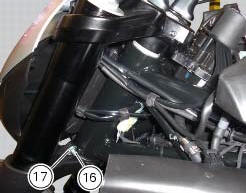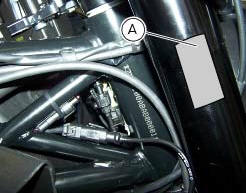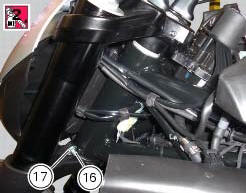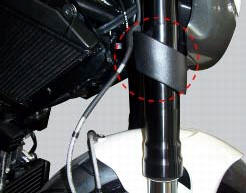
Ducati Diavel Service Manual: Steering angle adjustment
Loosen the nuts (17) and adjuster screws (16) on both sides of the bottom yoke.

Use a 6 to 6.5 Mm spacer (a) fitted to the fork outer tube, or use a gauge.

Turn the front forks to the right until the spacer (a) is seated against the frame top tube.
Tighten the adjuster screw (16) to bring it into contact with the stop on the steering head.
Apply threadlocker to the thread of nut (17). Hold the adjuster screw (16) firm and tighten the nut (17). Turn the forks to the opposite side: and repeat the process to adjust the other dowel and tighten the relative lock nut.

Once adjusted, set handlebar completely turned right and ensure that the gap between front brake line and lower frame trellis is at least 1 mm. If it is not so, decrease steering angle by working the right-hand adjuster.

 Adjusting the steering head bearings
Adjusting the steering head bearings
Note
To adjust the steering bearing clearance, follow what is described in
sect. 4 - 3, Adjusting the steering head bearings.
If the problems found are not solved, check the wear of steering beari ...
 Removal of the steering head components
Removal of the steering head components
Note
All parts fitted to the top and bottom yokes, including the wiring and
control cables, can remain on the motorcycle
provided they do not hinder the following operations.
Loosen the screw ...
Other materials:
Removal of the air filters
Work on the vehicle right side, loosen screws (3) that secure the intake duct
(2) to the airbox, and the radiator retaining
screw (a); recover the washer (b).
Remove the intake duct (2).
Proceed in the same way to remove the lh intake duct (6), and disconnect the
connector (c) ...
Key-on/key-off using the pin code (immobilizer release)
Key-on can be performed by pressing the button (7) on the
hands free lock (1, fig. 77) Without the presence of the keys
(3, fig. 77) And (4, fig. 77) And entering the pin code on the
dashboard.
Key-off can be performed by pressing the button (6) on the
handlebar / hands free key (7) / engine ...
Refitting the rear suspension
Lubricate the thread and underside of the special screw (1).
Insert the lower side of the shock absorber into the swingarm and insert the
screw (1).
Tighten the screw (1) to a torque of 45 nm +/- 5% (sect. 3 - 3, Frame torque
settings).
Lubricate bushes (5) and (6) with recommended gr ...